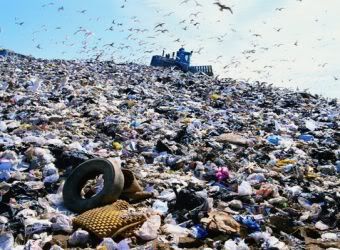European parliament backs waste prevention and cradle-to-cradle design
 Earlier we had a look at bioplastics and how their development must be seen in the broader context of the emerging bioeconomy. Currently, our consumer societies produce enormous amounts of 'bad waste', often based on petroleum products, that either ends up in toxic landfills or is burned and releases carbon. Biopolymers, bioplastics and plant-based products on the contrary would be biodegradable and drive a closed-cycle design philosophy. Products made from plants result in 'good waste': throwing them away comes down to fertilising soils on which new biomass grows. In such a universe, waste is welcome. The more of it, the better (earlier post).
Earlier we had a look at bioplastics and how their development must be seen in the broader context of the emerging bioeconomy. Currently, our consumer societies produce enormous amounts of 'bad waste', often based on petroleum products, that either ends up in toxic landfills or is burned and releases carbon. Biopolymers, bioplastics and plant-based products on the contrary would be biodegradable and drive a closed-cycle design philosophy. Products made from plants result in 'good waste': throwing them away comes down to fertilising soils on which new biomass grows. In such a universe, waste is welcome. The more of it, the better (earlier post).On Tuesday, the European Parliament's Environment Committee implicitly voted in favor of such a future by taking the European Union's policies on waste a step further. The Environment Committee gave its backing to the principle of a "hierarchy of waste" - which ranks waste treatment solutions by their environmental impact - when it voted on Tuesday on the draft revision of the framework directive and the thematic strategy on waste proposed by the Commission. MEPs also called for various clarifications, including a clear distinction between waste and useable by-products.
Five-stage waste hierarchy
The Environment Committee regards the new approach suggested by the Commission, based on the "life-cycle" of a product, as too theoretical. It prefers to stick "as a general rule" to a policy of a "waste hierarchy", which ranks treatments in five categories, from the most to the least environmentally-sound: 1. prevention, 2. re-use, 3. recycling, 4. other recovery operations, 5. disposal. It says Member States should be allowed to depart from this hierarchy "when life-cycle assessments and cost-benefit analyses indicate clearly that an alternative treatment option shows a better record".
Cradle-to-cradle
MEPs are also calling for total waste production to be stabilised by 2012 (compared to the 2008 position). The Commission is asked to propose indicators by 2008 for assessing progress made by Member States and to formulate by 2010 a "product eco-design policy" as well as targets for waste reduction. Such a product design policy will take on the form of promoting cradle-to-cradle design across the board. Cradle-to-cradle design means a product's components can be entirely re-used either in their original context, or in new products:
 biomass :: energy :: sustainability :: bioplastics :: biodegradable :: bioeconomy :: waste :: recycling :: cradle-to-cradle :: European Union ::
biomass :: energy :: sustainability :: bioplastics :: biodegradable :: bioeconomy :: waste :: recycling :: cradle-to-cradle :: European Union ::Member States' duties
For the first time, the directive also introduces waste prevention targets for the EU. The aim is that the member states will stabilise their waste production by 2012 to the level produced in 2008.
The Environment Committee wishes to simplify the requirements for national waste management programmes, to make them less bureaucratic and more compatible with the subsidiarity principle. MEPs say the requirement for the Member States to ensure that "all waste undergoes recovery operations" should apply "where practicable". National authorities must also do whatever is needed to ensure that the collection, production and transportation of hazardous waste, as well as its storage and treatment, are carried out in conditions providing optimum protection for the environment, and to ensure that mineral waste oils are collected separately. And all hazardous waste treatment installations must have a permit.
Incinerators
For incinerators and the use of waste as an energy source, MEPs approved the energy efficiency criteria as proposed by the Commission, but asked that operators be given longer to implement them. They also asked that the grant of permits for these operations be subject to a high level of energy efficiency.
Thematic strategy
In addition, in an own-initiative report drafted by Johannes Blokland (IND/DEM, NL), MEPs approved a package of recommendations to the Commission's thematic strategy. These seek to ensure that, in waste policy, the Commission's use of comitology (implementing decisions taken by committees of experts) is restricted to technical and scientific matters, and to underline the importance of the five-stage waste hierarchy. MEPs also call on the Commission to put forward various legislative proposals (on practical measures for waste prevention, new indicators, specific directives on biodegradable waste, construction and demolition waste and sewage sludge, and a revision of the directive on storing waste).
More information:
European Parliament: Environment Committee takes first steps to sort waste directive - 28 November 2006
Euractiv: MEPs back waste-prevention targets, reject burning - 29 Novermber 2006
 -------------------
-------------------
 Spanish company Ferry Group is to invest €42/US$55.2 million in a project for the production of biomass fuel pellets in Bulgaria.
The 3-year project consists of establishing plantations of paulownia trees near the city of Tran. Paulownia is a fast-growing tree used for the commercial production of fuel pellets.
Spanish company Ferry Group is to invest €42/US$55.2 million in a project for the production of biomass fuel pellets in Bulgaria.
The 3-year project consists of establishing plantations of paulownia trees near the city of Tran. Paulownia is a fast-growing tree used for the commercial production of fuel pellets.









0 Comments:
Post a Comment
Links to this post:
Create a Link
<< Home